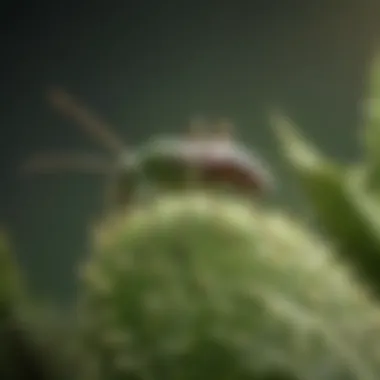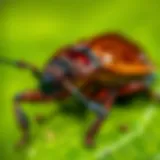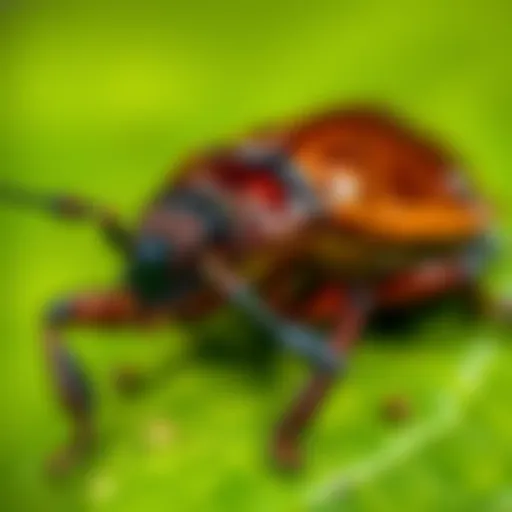Understanding Greenway Pest Management: Strategies


Intro
Greenways are essential for maintaining biodiversity and providing aesthetics to residential areas. However, they also attract various pests which can pose a threat to gardens and other plants. Understanding these greenway pests is vital for homeowners who wish to maintain a healthy garden environment. This section focuses on identifying common greenway pests, recognizing signs of infestations, and understanding effective strategies for prevention and treatment.
Pest Identification
Detailed Descriptions of Common Pests
Several pests commonly infest greenways and gardens. One of the more prevalent pests is the aphid, a small insect that feeds on plant sap. Aphids can be found in clusters and often appear on new growth. Another common pest is the Japanese beetle, identifiable by its metallic green body and copper-colored wings. These beetles can cause significant damage to foliage by skeletonizing leaves. Additionally, spider mites are a concern, especially in hot, dry conditions. They are tiny, often invisible to the naked eye, and they leave a characteristic webbing on plants.
Signs and Symptoms of Infestations
Identifying a pest infestation early can help mitigate damage. Look for:
- Discolored leaves: Yellowing or browning leaves may indicate pest activity.
- Wilting plants: This may suggest underlying pest problems, such as root damage or sap loss.
- Webs or staining: Specific pests, like spider mites, produce webs, while others may leave behind a sticky residue called honeydew.
"Early identification of pests significantly lowers the risk of extensive damage and costly repairs."
Prevention Strategies
Home Maintenance Tips for Pest Prevention
Regular maintenance can enhance a garden's resilience against pests. Here are some practical tips:
- Trim overgrown plants and shrubs to improve airflow.
- Keep the garden free of debris and fallen leaves, which can harbor pests.
- Water plants early in the day to reduce the humidity that pests thrive on.
Natural Deterrents and Barriers
Utilizing natural deterrents can help in pest prevention without resorting to harsh chemicals. Consider:
- Companion planting: Certain plants, like marigolds, can repel harmful insects.
- Homemade sprays: Mixtures of water and soap can effectively disrupt aphids' ability to cling to plants.
- Physical barriers: Row covers can protect crops from pests without harming them.
Treatment Options
Overview of Chemical vs. Natural Treatments
Choosing an appropriate treatment depends on the severity of the infestation. Chemical treatments, such as insecticides, can provide quick relief but may have harmful effects on beneficial insects. Natural treatments, on the other hand, tend to be safer for the ecosystem but may require multiple applications.
Step-by-Step Guides for DIY Treatments
For those seeking to treat infestations at home, here’s a simple guide for a homemade solution:
- Mix one teaspoon of dish soap with one quart of water.
- Shake the mixture well until it’s combined.
- Spray directly onto affected areas, ensuring coverage on both sides of leaves.
- Repeat every few days until the pest issue is resolved.
Prelims to Greenway Pest
The topic of greenway pests is crucial for various reasons. Greenways serve as valuable habitats for biodiversity but can also become havens for pests that may damage vegetation and pose health risks. Understanding greenway pests equips homeowners and pest control professionals with essential tools for effective management. It also emphasizes the significance of recognizing these pests early, which is vital for minimizing potential damage and ensuring a healthy garden environment.
Definition of Greenway Pest
A greenway pest refers to any unwanted organism that resides within greenways and can negatively affect native plant species, human health, or local ecosystems. These pests may include insects, rodents, or diseases that thrive in these environments. Identifying these pests is key to implementing effective management strategies. Their presence can disrupt the balance of local ecosystems. Proper definition and identification allow for targeted actions to control their populations.
Significance in Ecosystems
Greenway pests can have considerable effects on ecosystems. They disrupt food chains, damage native flora, and contribute to decreased biodiversity. For instance, certain insects can decimate plant populations, leading to habitat loss for local wildlife. This underscores the interconnectedness of ecosystems; a pest outbreak can initiate a ripple effect, influencing plant-animal interactions. Effective management of these pests is essential for preserving the ecological integrity of greenways.
"Effective management of greenway pests is not just about protecting gardens; it is about maintaining the balance of our local ecosystems."
Common Types of Greenway Pests
The examination of common types of greenway pests plays a crucial role in recognizing threats to gardens and ecosystems. Identifying these pests early can save significant effort and resources. Knowledge of pests helps homeowners and pest control professionals adopt effective management strategies. This section elaborates on the identification and understanding of greenway pests, key to preventing infestation and maintaining healthy environments.
Identification of Greenway Pests
Identifying greenway pests is the first step in managing them effectively. There are several types that are often encountered:
- Aphids: Small, often green or black insects that suck sap from plants, causing wilting and stunted growth.
- Japanese Beetles: Recognizable by their metallic green color, these pests feast on leaves and flowers.
- Spider Mites: Tiny arachnids that create webbing on plants, leading to leaf discoloration.
- Whiteflies: Winged insects that cluster on the underside of leaves and can transmit plant viruses.
Visual identification methods are helpful. One can regularly inspect plants for physical signs of pests. For example, sticky residue, droppings, or visible insects indicate a pest problem. Apps and online guides can assist in the identification process. These tools can simplify the recognition of various species and their specific impacts.


Behavior and Ecology
The behavior and ecology of greenway pests are fundamentally intertwined with their management. Understanding their patterns aids in prevention strategies. For instance, many pests reproduce quickly. Aphids can double their population in a week under favorable conditions.
Pests like Japanese beetles typically emerge in the summer. They often feed on flowers and fruits, which can be particularly problematic for homeowners who cultivate ornamental and edible plants. Spider mites thrive in dry conditions. They can become highly problematic in drought periods.
Certain environmental factors influence pest behavior:
- Temperature: Higher temperatures usually lead to increased pest activity and reproduction.
- Moisture: Pests like whiteflies prefer humid environments.
- Plant Health: Healthy plants are less likely to become infested, making plant care essential.
"Understanding the ecological role of pests can provide insight into their management and control strategies."
Recognizing the patterns in their behavior helps in devising effective control strategies. By correlating pest activity with environmental conditions, management plans can be tailored, allowing for prompt actions that minimize damage. This proactive approach is beneficial for maintaining the vibrancy of greenways, ensuring a harmonious balance within the ecosystem.
The Role of Greenways in Pest Habitat
Greenways play a significant part in pest habitats, influencing both pest populations and their interactions with the environment. Understanding these dynamics is crucial for effective pest management strategies. Greenways can support biodiversity but can also serve as corridors facilitating the movement of pests. The design and maintenance of these green areas directly affect how pests thrive and how easily they can spread to nearby urban settings.
Attributes of Greenway Environments
Greenway environments have several attributes that contribute to their role as pest habitats. They often include varied vegetation, water sources, and open spaces.
- Biodiversity: This is one of the key features of greenways. A diverse range of plants can provide habitat for various pest species as well as their natural predators. This diversity can create a balanced ecosystem but might also increase the chances of pest invasion.
- Microclimates: Greenways create microclimates that can be more favorable for certain pests. These areas often have different humidity and temperature levels compared to urban environments, which can promote pest survival.
- Pathways and Movement: The layout of greenways often facilitates the movement of pests between different habitats. This connectivity can allow pest populations to expand quickly, increasing the challenge for control.
- Food Resources: Many pests rely on specific plants. Greenways with dense plant coverage offer abundant food sources, contributing to higher pest populations.
By understanding these attributes, homeowners and pest control professionals can better anticipate the presence of pests and employ suitable strategies for control and prevention.
Impact of Urbanization
Urbanization significantly alters the role of greenways in pest habitats. As cities grow, the natural landscapes they replace can dramatically influence pest dynamics.
- Fragmentation of Habitats: Urban development often fragments natural habitats. Greenways may become isolated pockets, making it harder for natural predators to reach pests. This can lead to pest population booms.
- Increased Human Activity: More people in urban areas can lead to higher rates of pest encounters. Human activity can disrupt natural pest control mechanisms, allowing certain pest species to thrive.
- Pesticide Use: Urban areas may also see increased pesticide applications, affecting non-target species and potentially causing pest resistance over time. The consequences can create further challenges in pest management.
Understanding the impact of these changes is vital for effective pest control and management strategies in greenways.
In summary, greenways play a dual role in pest habitats. Recognizing the attributes of these environments and the influences of urbanization helps in formulating effective pest control strategies.
Impact of Greenway Pests on Human Activities
The presence of greenway pests has significant implications for human activities, particularly in areas such as horticulture, agriculture, and even urban planning. It is crucial to understand how these pests affect not only plant life but also the well-being of humans and their pets. This section delves into two critical aspects: the damage to vegetation and the potential health risks posed by these pests.
Damage to Vegetation
Greenway pests are notorious for causing extensive damage to various types of vegetation. They feed on the leaves, stems, and roots of plants, which can lead to decline in plant health. This damage often manifests in the form of wilting leaves, stunted growth, and overall poor vigor of the plants.
- Common vegetative consequences include:
- Leaf discoloration: Many pests cause leaves to turn yellow or brown, often indicating stress or nutrient deficiency.
- Reduced yields: In agricultural settings, pest damage can drastically reduce crop yields. This not only affects livelihoods but also food security.
- Loss of biodiversity: Essential plants may die off due to pest infestations, leading to a decline in local biodiversity which can disrupt local ecosystems.
Homeowners and gardeners facing pest-related damage must consider effective management strategies. This includes early identification and understanding the specific pests involved. By recognizing signs of infestation promptly, one can mitigate damage before it escalates. Maintaining healthy plants through proper care can also make them less susceptible to pest attacks.
"Early detection is key to minimizing the impact of pests on vegetation."
Health Risks to Humans and Animals
Beyond the visible damage to plants, greenway pests can pose health risks to humans and animals. Certain pests, such as ticks and mosquitoes, are vectors for diseases that can have severe health implications. For instance, mosquitoes are known carriers of diseases like West Nile virus and Zika virus.
- Health concerns related to pests include:
- Allergic reactions: Some individuals may experience allergic responses to insect bites or in reaction to pest saliva, particularly in children.
- Disease transmission: Pests such as fleas, ticks, and mosquitoes can transmit serious diseases to both humans and pets, often leading to hospital visits.
- Psychosocial impact: The presence of pests creates a different layer of stress for homeowners, as concerns about health and property damage can lead to anxiety.
It is essential to have a clear strategy in place for pest prevention and control. This not only safeguards plants but also protects the health of your family and pets. Awareness and education play a significant role in minimizing these risks.
In summary, understanding the impact of greenway pests on human activities is vital. Recognizing both the agricultural consequences and the health implications enables proactive measures, fostering healthier environments in our residential and urban spaces.
Integrated Pest Management Approaches
Integrated Pest Management (IPM) is a comprehensive strategy aimed at managing pests in an economically and environmentally sustainable way. The importance of IPM in this context cannot be overstated, as it combines various management practices to create a balanced approach that minimizes the reliance on chemical pesticides. This is particularly relevant for homeowners and professionals alike, as it fosters a healthier ecosystem while also addressing pest issues effectively.
Assessment and Monitoring
Assessment and monitoring are critical components of IPM. Regularly evaluating the pest populations and their potential impact on plants is essential. Homeowners should familiarize themselves with the signs of infestations, which include visible damage to foliage, unusual insect activity, or the presence of pest excretions. Utilizing tools such as pest traps or sticky boards may also enhance monitoring efforts.


- Regular Checks: Inspect gardens and greenways on a consistent schedule.
- Record Keeping: Maintain detailed notes of pest observations to track trends and changes.
Monitoring not only aids in early detection but also serves as the foundation for informed decision-making. Identifying the pest species allows for the selection of the most appropriate control measures, preventing unnecessary interventions that could harm beneficial organisms.
Preventive Measures
Preventive measures are an integral part of IPM. By creating environments unfavorable to pests, homeowners can significantly reduce pest populations before they become problematic. Some effective strategies include:
- Crop Rotation: Changing plant types each season minimizes pest establishment.
- Soil Health: Maintaining healthy soil through composting and mulching is critical for plant vitality and resilience.
- Native Plant Selection: Incorporating native plants can attract beneficial insects which act as natural predators to pests.
Additionally, proper sanitation practices are vital. Removing debris, dead plants, and weeds can lessen the chances of pests hiding and reproducing. This proactive approach requires consistent effort but can yield substantial benefits in pest control.
Control Strategies
When pest populations exceed acceptable levels, targeted control strategies become necessary. Understanding the specific pest cycle is essential for effective intervention. Control strategies can be categorized into several types:
- Biological Controls: Introducing natural predators or parasites can effectively reduce pest populations without chemicals.
- Cultural Controls: Adjusting farming practices such as irrigation, planting times, and crop spacing may discourage pest development.
- Chemical Controls: If other methods are insufficient, applying pesticides should be done with caution. Choose selective pesticides that target specific pests while minimizing harm to beneficial insects.
Effective integration of these strategies allows homeowners to address pest problems efficiently while maintaining a focus on environmental health.
Natural Pest Control Methods
Natural pest control methods offer an vital approach to managing greenway pests in a sustainable way. These strategies emphasize ecological balance, often utilizing predatory species or natural processes. Homeowners can employ these methods with varying degrees of complexity, helping to reduce chemical reliance while promoting a healthier environment. Using natural methods is environmentally friendly and often safer for families and pets compared to synthetic pesticides.
Biological Control Agents
Biological control agents are living organisms that can naturally suppress pest populations. This group includes predatory insects, parasitoids, and pathogens that target specific pests. For example, ladybugs can effectively control aphid populations, while nematodes attack soil-dwelling pests like grubs. When selecting biological control agents, it's essential to consider the compatibility with local ecosystems.
Benefits of using biological control agents include:
- Minimal environmental impact
- Reduction in pesticide usage
- Long-term pest management solutions
However, introducing these agents may require careful monitoring to ensure they establish without becoming invasive. Understanding their life cycles and behaviors can provide insight into successful applications.
"Natural control methods can restore balance in the garden ecosystem, fostering resilience against pest outbreaks."
Cultural Control Practices
Cultural control practices involve modifications to the environment or cultivation techniques to deter pests. Common practices include crop rotation, companion planting, and maintaining healthy soil. These methods aim to create less favorable conditions for pests while promoting the overall health of plants.
For instance, rotating crops can disrupt pest life cycles, while companion planting can naturally repel pests or attract beneficial insects. Additionally, improving soil health through organic amendments can lead to stronger plants that are more resistant to pest damages.
Key aspects of cultural control practices include:
- Enhancing plant biodiversity
- Using resistant plant varieties
- Proper sanitation to remove pest habitats
These methods often require dedication and follow-through, but the long-term benefits can greatly reduce reliance on chemical treatments.
Chemical Control Options
Chemical control is a significant aspect of managing greenway pests. It involves the use of pesticides to eliminate or mitigate pest populations. This method is often considered when other management strategies fall short. Homeowners might find it a viable option, especially if pests pose a substantial threat to their gardens or landscaping.
The benefits of using chemical control can be immediate. Pesticides can provide quick results, making them attractive to those struggling with fast-replicating pest populations. However, reliance on chemical solutions must be considered carefully due to potential side effects on non-target species, including beneficial insects, pets, and humans.
Factors to keep in mind when using chemical control include:
- Pest Identification: Correctly identifying the pest is crucial as different pests may require specific types of pesticides.
- Timing of Application: Applying pesticides at the right time amplifies effectiveness. Pests that are in their active growth stages may be more susceptible to treatment.
- Environmental Impact: Understanding the potential impact on the surrounding ecosystem is essential. Some chemicals can cause harm beyond the intended target, affecting water quality or non-target organisms.
"Chemical control should be part of an integrated approach, not the only method relied upon."
Types of Pesticides
When dealing with greenway pests, there are several classes of pesticides to consider:
- Insecticides: Designed to kill insects, they can be broad-spectrum or targeted. Broad-spectrum insecticides affect a wide range of insects, while targeted products are specific to certain pest types.
- Herbicides: These control unwanted plant growth and are important if pests include invasive plant species that threaten garden health.
- Fungicides: Used to treat fungal infections that can harm plants and may be applied preventively or reactively.
- Miticides: Target mites, which can be devastating to foliage, particularly in greenway settings.
Each type plays a different role in pest management and should be chosen based on the specific needs of the situation.
Application Guidelines


Proper application of pesticides is crucial to ensure both effectiveness and safety. Here are some essential guidelines:
- Read Labels: Always begin by reading the pesticide labels. They contain critical information on safe and effective use, including dosage.
- Use Protective Gear: When applying chemicals, wear appropriate protective gear, such as gloves and masks, to minimize exposure risks.
- Apply at Recommended Times: Certain conditions, such as humidity and temperature, affect the efficacy of the application. Morning or late afternoon is often recommended to avoid evaporation in the heat.
- Follow the Dosage Recommendations: Over-application not only wastes product but can harm the environment and lead to pest resistance.
- Avoid Water Runoff: Do not apply before a rainstorm or in windy conditions to prevent pesticides from entering water sources or affecting non-target areas.
Incorporating these practices will help ensure that chemical control options are used effectively and responsibly, ultimately contributing to a healthier garden environment.
Case Studies of Greenway Pest Management
Case studies in pest management provide valuable insights into real-world applications and outcomes. They allow us to analyze the effectiveness of various strategies implemented in different environments. This section underscores the importance of learning from past experiences, both positive and negative. By examining specific examples, homeowners and pest control practitioners can refine their approaches to managing greenway pests. The benefits of such studies include enhanced understanding, recognition of practical tactics, and identification of pitfalls from which to learn.
Successful Management Strategies
Various case studies showcase successful pest management strategies in greenway environments. One notable example involves the use of integrated pest management (IPM) in urban parks. In a community park plagued by aphids, park managers adopted an IPM approach incorporating biological control agents—specifically ladybugs. By releasing these natural predators in the affected areas, the aphid population significantly reduced without the need for chemical pesticides.
Another successful case highlighted the effectiveness of planting pest-resistant vegetation. In a suburban setting, homeowners replaced traditional rose varieties susceptible to Japanese beetles with more resilient types. This change diminished beetle infestations, leading to healthier plants and less reliance on invasive control measures.
From these examples, several key strategies emerge:
- Biological Controls: Utilizing natural predators can help keep pest populations in check.
- Resistant Plant Varieties: Choosing plants that are less appealing to pests can minimize infestations.
- Regular Monitoring: Diligently monitoring plant health allows for early detection of potential issues.
Lessons Learned from Failures
However, not all pest management strategies yield positive results. Case studies also reveal missteps that offer crucial lessons. One particular instance involved the over-reliance on chemical pesticides in a community garden. Initially, the strategy seemed effective, as pest numbers decreased promptly. Yet, the long-term consequences included a decline in beneficial insect populations, which led to recurrent pest outbreaks.
Another cautionary tale underscores the importance of proper identification before implementing management methods. A case in which homeowners mistakenly targeted non-threatening insect species—like pollinators—demonstrated that not all pests are equally harmful. This resulted in a loss of vital pollinator populations, ultimately damaging the garden's overall health.
In summary, important lessons from failures include:
- Sustainable Practices: Balance between chemical and natural controls fosters healthier ecosystems.
- Correct Identification: Ensuring accurate pest identification helps prevent unnecessary harm to beneficial species.
These case studies highlight the complexity of greenway pest management, emphasizing the need for a thoughtful approach.
"Knowledge gained from past experiences shapes better future practices in pest management."
Understanding these varied aspects of pest management not only enlightens readers but also inspires proactive steps in their own pest control efforts. By integrating successful strategies while learning from past mistakes, anyone can develop a robust framework for managing greenway pests effectively.
Future Trends in Greenway Pest Management
The evolving landscape of pest management is crucial for homeowners and pest control professionals alike. As greenway pests become more sophisticated, effective strategies must adapt to counter emerging threats. Today, we explore emerging trends shaping the future of pest management, spotlighting technological advancements and ongoing research efforts.
Technological Innovations
Technology is a driving force in enhancing pest management. The integration of innovative tools simplifies identification and monitoring processes. Remote sensing, for instance, allows for the detection of pest populations before significant damage occurs. Drones equipped with imaging systems can survey vast greenway areas, providing data swiftly.
Another noteworthy development is the implementation of machine learning. This technology can analyze patterns in pest behavior, predicting outbreaks. Homeowners benefit as they can implement preventative measures backed by data-driven insights. Additionally, automation plays a role. Smart traps using sensors can notify homeowners of pest activity, allowing for timely intervention.
Furthermore, the rise of bioinformatics aids in understanding pest genetics and their resistance to treatments. By using genetic mapping, researchers can identify specific traits that contribute to pest survival, guiding the development of targeted control measures. These advancements ultimately contribute to maintaining healthier environments and reducing reliance on broad-spectrum pesticides.
Research and Development Focus
Ongoing research remains vital in the pursuit of effective pest management. Scientists are increasingly focusing on sustainable practices and integrated pest management (IPM) approaches. This shift emphasizes reducing chemical inputs while enhancing biological control methods.
Projects investigating the role of native predators in controlling pest populations are gaining traction. Encouraging biodiversity within greenways not only enhances ecosystem resilience but also harnesses natural processes to maintain pest levels. Studies suggest that planting diverse vegetation can attract beneficial insects, such as ladybugs and lacewings, which help control plague insects.
Moreover, collaboration between researchers and technology developers is paving the way for innovative solutions. For instance, the use of mobile apps aids in pest identification and reporting, creating substantial data pools for further research. These citizen science initiatives empower homeowners to contribute to the understanding of pest dynamics in their areas.
In summary, the future of greenway pest management lies in a blend of technology and sustainable practices. As homeowners become more informed, they are better equipped to implement advanced strategies that consider both effectiveness and environmental health. Embracing these changes ensures long-term solutions for pest issues, benefiting not just individual properties, but also the overall ecosystem.
Closure and Key Takeaways
As we have explored, managing greenway pests involves a multifaceted approach that integrates various strategies to mitigate their impact. Understanding the significance of early identification, adopting preventive measures, and employing both natural and chemical control methods are essential. Homeowners and pest control professionals should prioritize these components to effectively safeguard their green spaces.
"Prevention is better than cure." This adage rings true in pest management.
Summary of Effective Strategies
- Early Identification: Recognizing pest presence at the earliest stage prevents larger infestations. Familiarity with the specific characteristics of greenway pests aids in timely intervention.
- Integrated Pest Management (IPM): This holistic approach combines monitoring, biological control, cultural practices, and judicious use of pesticides. IPM offers a sustainable way to cope with pest issues while minimizing environmental impact.
- Cultural Controls: Implementing methods such as crop rotation, habitat manipulation, and maintaining healthy plant practices can reduce pest attractiveness and resilience.
- Chemical Controls: When necessary, using pesticides should be done according to strict application guidelines. This reduces the risk of potential harm to beneficial organisms and the ecosystem. Always select products labeled as safe for greenway environments.
Encouragement for Proactive Management
Encouraging proactivity in pest management cannot be overstated. Homeowners should cultivate a mindset that looks beyond traditional responses. Regular monitoring for signs of pest activity can lead to quicker resolution before issues escalate.
Moreover, engaging in community education about pest management raises awareness and collective preparedness. Making informed decisions about gardening practices creates a healthier environment. This not only impacts individual spaces but the wider ecosystem as well.
In summary, taking a proactive stance in managing greenway pests creates not only a thriving garden but also contributes positively to local biodiversity. Keeping informed, maintaining open communications with professionals, and adapting strategies based on current knowledge enhances the overall effectiveness.
Continued vigilance is the key to achieving success in pest management, ensuring the longevity of your green spaces.



